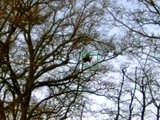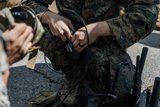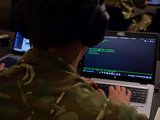Augmented reality applications inch closer
British BAE Systems engineers are working with the University of Birmingham to develop augmented reality applications, the company announced on 11 May.
The applications being collaborated on include a briefcase-sized portable command centre for emergency scenarios that creates a virtual workspace. It uses commercial technology to create a semi-virtual environment, and users can use a virtual reality headset and interactive gloves to interface with the mixed reality control station that appears around them. Users can monitor situations, zoom in and manipulate environments, direct troops and pull in virtual video screens that allow them to monitor news channels and feeds from UAVs.
BAE Systems and the university are also working to develop a virtual cockpit that provides infinitely reconfigurable virtual displays and controls, allowing pilots to customise their interface with the aircraft based on their preferences, mission objectives and task at hand. The technology is designed to be easily upgraded and customised.
Nick Colosimo, futurist, BAE Systems, said: 'We’re already seeing virtual and augmented reality becoming more commonplace in consumer products, and the possibilities it offers the armed forces are hugely exciting. Our unique approach will identify the optimal balance between the real world and the virtual – enhancing the user’s situational awareness to provide battle-winning and life-saving tools and insights wherever they may be.
'Through collaborating with the University of Birmingham, we are able to bring together some of the best minds available in this subject area to develop these concepts and evolve the technology itself.'
Bob Stone, simulation & human factors specialist, University of Birmingham, said: 'Being able to physically manipulate virtual objects in the real world has been challenging scientists for 40 years. Since my first virtual reality experience at NASA nearly 30 years ago, the technology has evolved from the primitive head-mounted displays and computers to today's world where we can interact with complex virtual objects, integrated in real-time with real-world scenarios.
'Our work with BAE Systems shows just how close we are to delivering the next generation of advanced mixed reality interfaces for future applications not only in defence, but also in such important domains as engineering and healthcare.'
More from Digital Battlespace
-
![Chess Dynamics successfully demonstrates Vision4ce AI-driven tracker]()
Chess Dynamics successfully demonstrates Vision4ce AI-driven tracker
The Vision4ce Deep Embedded Feature Tracking (DEFT) technology software is designed to process video and images by blending traditional computer vision with artificial intelligence (AI) algorithms to present actionable information from complex environments.
-
![Wave Relay devices cleared for security use on commercial systems in industry trend]()
Wave Relay devices cleared for security use on commercial systems in industry trend
Persistent Systems has been cleared by National Security Agency (NSA) to transmit sensitive data on commercial networks. The devices are added to the NSA’s Commercial Solutions for Classified (CSfC) component list which also includes other companies’ products providing the same security.
-
![UK teases cyber spending boost in Strategic Defence Review ahead of “imminent” release]()
UK teases cyber spending boost in Strategic Defence Review ahead of “imminent” release
The release of the UK’s Strategic Defence Review (SDR) has been long promised as mid-year. It is possible it could be as early as 2 June although the UK Ministry of Defence (MoD) continues to play its cards close to its chest.
-
![Intelsat emphasises SATCOM resilience for SOF in contested domains (video)]()
Intelsat emphasises SATCOM resilience for SOF in contested domains (video)
Intelsat outlines how its multi-orbit SATCOM architecture is enhancing connectivity and resilience for special operations forces operating in degraded and contested environments.
-
![US Space Force’s next-generation missile warning system moves forward with $500 million in new contracts]()
US Space Force’s next-generation missile warning system moves forward with $500 million in new contracts
Next-Generation Overhead Persistent Infrared (Next-Gen OPIR) satellites are intended to provide early warning of missile launches from any location worldwide and new ground stations will result in expanded coverage of critical missile warning.
























